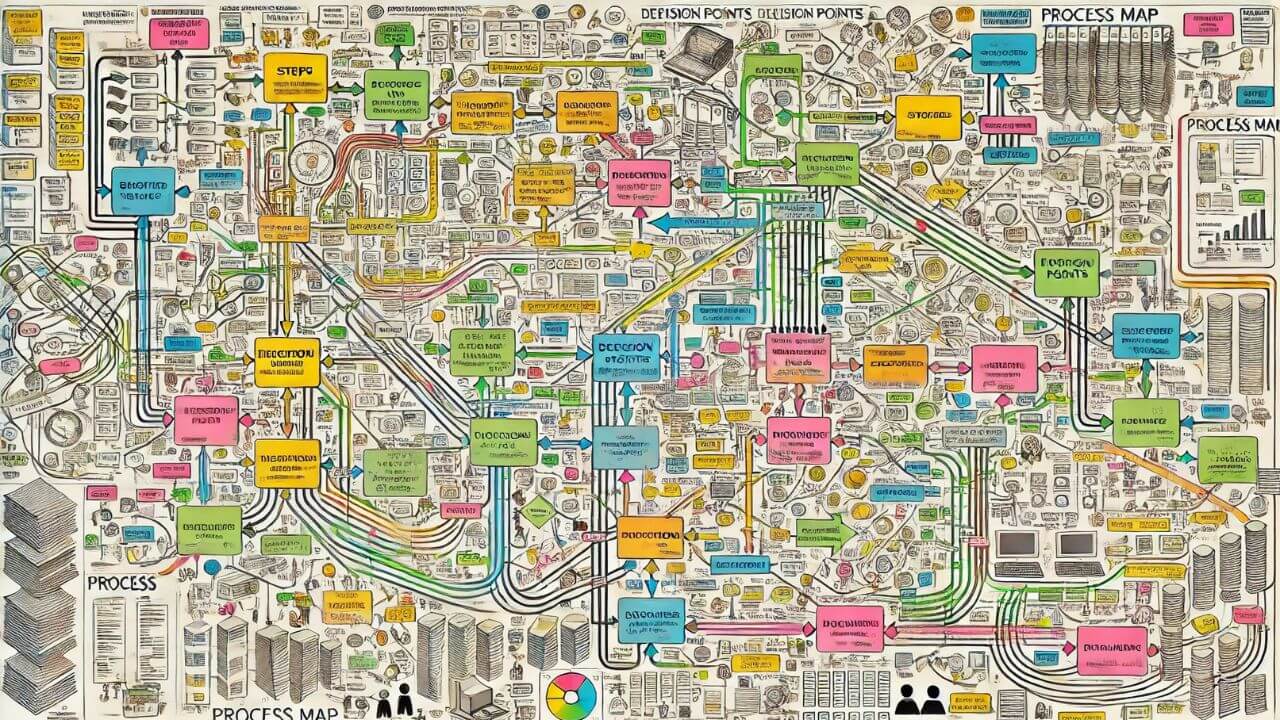8 Common Process Mapping Mistakes That Keep Small Business Owners Stuck
Mar 14, 2025
When I first started documenting my processes, I thought I knew what I was doing. I’d read the books, taken the courses, and even had some sessions with a systems expert who helped bigger businesses streamline everything.
So I got my team together, set up the whiteboard, got the post-it notes out and picked what I thought was a logical place to start - our purchasing process.
We started mapping. Place an order with a supplier - easy. But what about ordering a new product? That’s different. What about when the stock arrives? Better include that. What about inventory? That’s part of purchasing, right?
Before I knew it, we’d mapped a monster. It was so big, so complicated, we couldn’t even fit it all on the board. We had no idea where it started and where it stopped.
So we took a break. We walked away, said we’d come back to it… but we never did.
I kept walking past the board, all the post-its and thinking, What am I doing wrong? The expert I’d learned from could map entire businesses in a few days. I kept seeing people post photos of their systems, fully documented, everything running smoothly.
Weeks went by. I kept tinkering, adding a bit here, a bit there. I got my team together for another go, but their frustration was clear: we couldn't just keep stopping everything to try and get this done.
Eventually, I had to admit it: What worked for a bigger business wasn’t working for me.

I couldn’t shut everything down to map out my whole business. I had to DIY it while actually running the business.
So I stopped trying to do everything all at once.
Instead of mapping the entire purchasing system, I picked one small process that was taking way too much of my time - placing a top-up order with a supplier.
That felt doable.
So I worked out the start and the finish, wrote down all the steps, then trained someone else to do them. Then I did the next small process. And the next.
And gradually, systemising didn't feel quite so hard anymore.
My team actually had processes they could follow, and I wasn’t the one holding it all together. And that? That’s why I teach it this way now.
Because most business owners? They start where I did - trying to document too much at once, getting overwhelmed, and giving up.
But you don’t need to systemise your whole business in one day (or even a week). You just need to start with one process, get it working, and build from there.
Why Process Mapping Goes Wrong
That experience taught me a hard but valuable lesson.
Most small business owners don’t give up on process mapping and systemising their businesses because they don’t see the value in it. They give up because it feels too big, too complicated, and just too hard.
I see it all the time. Business owners start with the best intentions, ready to get their systems in place. But then they hit the same roadblocks I did.
They follow advice meant for big businesses (you DON’T need to systemise like McDonalds!) and get lost in frameworks that don’t apply.
They make it so detailed that no one actually uses it. So the process mapping project gets pushed aside, and they go back to doing everything themselves.
They overthink it - trying to make everything perfect.
But you know what? You don’t have to get stuck here.
When you get this right, you’ll have simple, clear process maps that actually make your business easier to run - instead of being just another thing that sounded good, but never actually got done.

The Common Mistakes (And How to Avoid Them)
Most small business owners don’t set out to make process mapping harder than it needs to be.
They just follow the wrong advice, overcomplicate things, or don’t know what to look out for.
But, when you know the common mistakes, they’re easy to avoid.
Here’s what trips most small business owners up - and how to make sure your process maps actually help you run your business more efficiently.
1. Not Keeping Process Maps Updated
Mapping out a process feels like progress - and it absolutely is.
But too many business owners treat it as a one-and-done task, something to tick off the list and forget about.
The problem? Businesses change.
- You switch software or tools.
- You tweak the way you handle customer orders.
- A step gets skipped because it doesn’t actually add value.
And before you know it, your process map is out of date because it's not how you're actually doing things.
That’s when things start to go wrong. The process map says one thing, but the team does something different. A new hire follows the wrong steps. Suddenly, the document that was meant to make life easier is causing more confusion than it solves.
The Fix: Keep It Simple, But Keep It Updated
- Check your key processes every six months. It doesn’t have to be a big project - just a quick review to see if anything’s changed.
- If a step changes, update the map straight away. It’s a two minute fix now, or a massive headache later when things aren’t working.
- Keep it practical. You don’t need to revise every tiny detail - just make sure the big steps still reflect what’s actually happening.
Your process map is a living document, not something to file away and forget. Keep it up to date, and it’ll keep your business running smoothly.
2. Making Them Too Complicated
It’s easy to fall into the trap of trying to cover every single possibility.
You start mapping a simple process - let’s say ordering stock.
But then you think…
- What if a supplier is out of stock?
- What if we need a new supplier?
- What if a product is delayed?
- What if it arrives damaged?
- What if we need a refund?
And before you know it, your process map is out of control.
Instead of being a simple, easy to follow guide, it turns into a huge mess - so complicated that no one can actually follow it.
The Fix: Keep It High Level
- Focus on the main process, not every "what if." If something happens occasionally, it doesn’t need to be in the process map.
- Use SOPs for the details. Your process map should show the flow, not every possible variation. If a step needs more explanation, that goes in an SOP.
- Think about usability. If someone can’t follow the process in seconds, it’s too complicated. A good process map makes things clear, not add confusion.
If it’s too detailed, no one will use it - and you’ve just wasted precious time creating something that doesn’t actually help.
3. Choosing the Wrong Tools
The right tool makes process mapping quick and easy. The wrong tool? It turns it into a frustrating time suck that makes you want to throw in the towel before you've even started.
A lot of small business owners default to whatever tool they already have, like a Word document or even a spreadsheet. Others dive into massively complex software designed for big corporations, thinking they need advanced features to “do it right.”
The problem?
- Basic tools like Word and Google Docs aren’t built for process mapping. You end up wrestling with shapes, arrows, and formatting instead of actually mapping the process.
- Enterprise level software is overkill for small teams. These kinds of process mapping tools are designed for big businesses with multiple departments and layers of approval - not a small business that just needs a clear, visual guide.
- Too much complexity = no one uses it. If the tool takes hours to learn, you’re less likely to actually finish mapping your processes - and even less likely to update them.
The Fix: Use a Simple, Visual Tool
- Stick to drag and drop tools like Whimsical, Miro, or Lucidchart - they’re designed to be easy and intuitive.
- Test a tool for 10 minutes before committing. If it feels frustrating or clunky, it’s not the right one.
- Keep it simple. You want a tool that lets you lay out your process quickly, not something that forces you to format text boxes for half an hour.
Documenting your process map in the software should be the easy part. The right tool makes it fast, clear, and actually useful - by getting the steps out of your head and into something visual
4. Not Using Standard Graphics
A process map should make things clearer, not more confusing. But if every map looks different - random shapes, inconsistent symbols, no clear flow - it’s hard to follow, even for the person who created it.
It might seem like a small detail, but messy, inconsistent maps lead to more problems:
- You waste time trying to work out what each shape means instead of focusing on the process.
- If you come back to the map months later, it's hard to update it because it feels like starting from scratch.
- As your team grows, no one knows how to read it because there’s no standard format.
The Fix: Keep It Simple and Consistent
Most process mapping tools come with built-in standard shapes—and there’s a reason for that.
Stick to these:
- Ovals for start/end points.
- Rectangles for tasks.
- Diamonds for decisions.
That’s all you need. No fancy shapes, no extra complications - instead, a clear, repeatable format that makes sense every time you (or anyone else) look at it. Keep it consistent, and you’ll spend less time re-learning your own maps and more time actually using them to improve your business.

5. Not Involving the Right People
Process mapping works best when it reflects what actually happens - not just what you think happens.
But if you’re mapping a process you don’t personally do, you’re probably missing steps, overcomplicating things, or assuming things work one way when they don’t.
It happens all the time. A business owner maps out a process, hands it over, and then:
- An important step is missing because it's in someone's head, not written down anywhere.
- A task takes twice as long as you thought because the real process is different.
- The team ignores the map because “that’s not how we actually do it.”
The Fix: The Process Should Come From the People Doing the Work
If you have a team, they should be the ones mapping the process. You can guide the conversation, but the people who actually do the work need to document how it happens in practice.
If you’re a solopreneur, don’t just map from memory. The next time you do the task, write down each step as you go—that’s how you capture what really happens.
Look for the hidden steps. The things people just know - but never think to write down - are often the ones that trip up a new hire.
A process map that comes from the people doing the work will always be more accurate - and actually useful - than one you've kind of guessed at.
6. Not Critically Assessing the Process Map
Just because you’ve mapped a process doesn’t mean it’s the best way to do it.
A process map (should!) shows what’s happening now, but that doesn’t mean it’s the most efficient or effective way to get the job done.
I see this all the time - business owners go through the effort of mapping a process, but instead of stepping back to evaluate it, they just accept it as is.
What happens?
- You do stuff even though you don't really need to because “that’s how we’ve always done it.”
- You don't fix bottlenecks or improve inefficiencies.
- You miss opportunities for automation or delegation so the process is slower than it needs to be.
The Fix: Take a Step Back, and Be Critical
Once you’ve mapped the process, take a step back and assess it properly:
Is this process efficient, or is there wasted time? Are there delays, waiting periods, or approvals that could be removed?
Can you eliminate any steps? If something doesn’t add value, why is it still there?
Could a tool or automation make it easier? If a task is repetitive or manual, could software handle it instead?
A process map should show you exactly what you're doing now, so that you can take a step back and think critically and find better ways to do what you're doing. Taking the time to review your process is a crucial part of making your business run efficiently.
7. Mapping the Ideal Process, Not the Real One
It’s easy to fall into the trap of mapping how you think a process should work instead of what's actually happening right now.
This is super common, especially when business owners want to “fix” a process while mapping it. The problem is that you're not basing it on reality.
What goes wrong when you do this?
- The process map doesn’t match what actually happens, so no one follows it.
- You miss the real inefficiencies because you’re mapping an ideal version that doesn’t exist.
- Team members get frustrated because they’re expected to follow a theoretical process that doesn’t fit how things actually work.
The Fix: Map What’s Happening Now First
- Document the process exactly as it happens today. Even if it’s messy or inefficient, capture what’s real - not what you think should be happening.
- Watch for workarounds. If a team member skips steps or does things differently, ask why - that’s where you'll find real improvements.
- Once the real process is mapped, then you can look at improving it. If you don’t understand what’s happening now, how can you fix it?
Start with what you've got. See what's working, and what's not. Then change what's not. Simple.
8. Buying Someone Else’s Process Maps
It’s tempting to look for shortcuts. Instead of mapping your own processes, why not just buy a pre-made process map from someone who’s already done it?
I get how this is tempting. The problem is, someone else’s process wasn’t built for your business. Even if their business looks similar to yours, their workflows, team structure, and tools will be different.
Copying their process map might seem like a timesaver, but in reality:
- It won’t match how your business actually runs, so you’ll have to tweak everything anyway.
- Your team won’t follow it - because it doesn’t reflect how they actually do the work.
- It adds complications instead of clarity - because you have to reverse engineer a system that doesn’t quite fit.
The Fix: Start With Your Own Workflows
- Map out how you already do things. Even if it’s not perfect, it’s real - and you can refine it from there.
- Use other people’s process maps for inspiration, not a plug and play solution. It’s fine to see how others structure their workflows, but your business already has its own system - it's how you do stuff everyday.
- Make it work for you, not the other way around. Your process maps should fit your team, your tools, and the way you work - not force you into someone else’s way of doing things. A process map only works if it reflects how your business actually operates.
- If you start with a template that doesn’t fit, you’ll spend more time fixing it than if you’d just mapped it yourself in the first place.
How to Do It Right (A Simple Approach)
Keep your process maps simple and practical, and make sure they reflect what actually happens in your business.
- Here’s what makes a process mapping easy: Start with one small process, not your full business systems.
- Choose something you do often and need to hand over - it’s the fastest way to see the benefits.
- Keep it high level - let SOPs handle the detail. If someone needs extra instructions, that belongs in your step by step procedures, not the process map.
- Review and refine as things change. A process that worked six months ago might not work today - so make updates when needed.
- Look critically at what you've got - what's working, what's not, and where can you improve?
A process map should give you clarity on how work actually gets done - so that anyone can do it.
Final Thoughts:
A process map shows you exactly how work gets done in your business - not just what you think is happening. When you can see every step laid out clearly, you can:
- Catch bottlenecks and wasted effort.
- Spot inefficiencies and remove extra steps that waste time.
- Hand over tasks faster, because everyone knows exactly what’s involved.
Freebie & Next Steps
Want to really get stuck into process mapping for your small business? Here’s what to do next:
Read: Master Process Mapping: The First Step to Simplifying Small Business Systems
Want to learn the S.I.M.P.L.E. way to map your processes and build your business systems? Grab my Simple Business Systems Starter course, where I walk you through exactly how to free up your time and build a business that runs without you.
Don't want to figure it out on your own? Book a call with me, and we’ll work out exactly where you’re getting stuck, and I'll show you how you can fix it.
Want more awesome tips on running a seriously systemised business?
Pop your details in below to get your weekly dose of awesomeness that will get you and your business running like a well oiled machine!
We don't do SPAM - the email kind or the tinned meat kind! We will never sell your information, for any reason.


